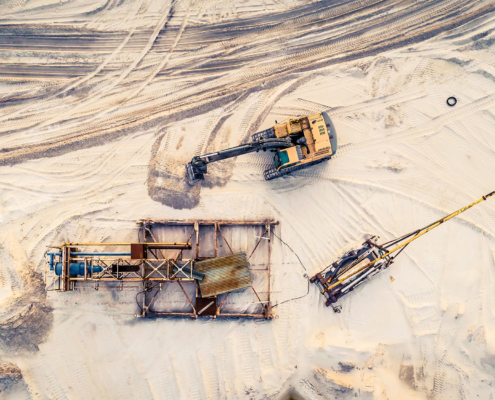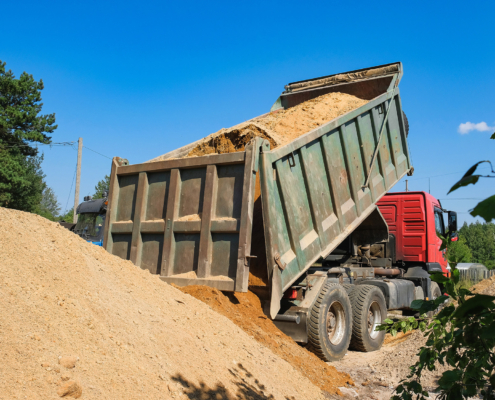 https://pontotocsandandstone.com/wp-content/uploads/2025/09/Frac-Sand-Market-Trends-and-Forecasts.jpg
1250
2000
AbstraktMarketing
/wp-content/uploads/2021/08/Pontotoc-White-Logo.png
AbstraktMarketing2025-09-05 20:26:142025-12-28 16:14:39Navigating Growing Demand: Frac Sand Market Trends and Forecasts
https://pontotocsandandstone.com/wp-content/uploads/2025/09/Frac-Sand-Market-Trends-and-Forecasts.jpg
1250
2000
AbstraktMarketing
/wp-content/uploads/2021/08/Pontotoc-White-Logo.png
AbstraktMarketing2025-09-05 20:26:142025-12-28 16:14:39Navigating Growing Demand: Frac Sand Market Trends and ForecastsWashing and Classifying Sand Solution Equipment
Frac sand, a key component in the oil and gas industry, is used to prop open fractures during fracing. Without proper cleaning and classifying equipment in place, frac sand can’t be used to its fullest potential.
In this article, we’ll discuss why washing and classifying are such important elements for optimal frac sand production and highlight different types of sand solution equipment.
What Is Frac Sand Used For?
Frac sand is a specialized type of sand used mainly in the oil and gas industry for hydraulic fracturing. It is made of natural or synthetic silica-based material and is highly resistant to weathering, chemical erosion, and abrasion. The small grains provide superior propping power when mixed with water and pumped down wells during fracing. Because frac sand must have just the right size, shape, and composition, it must be carefully washed and classified before it can be used in fracing.
The Importance of Washing and Classifying Equipment for the Fracing Process
To preserve its integrity and maximize its value, frac sand needs to be regularly cleaned and processed through washing and classifying equipment. This ensures that only particles of a certain size are released into storage. It also helps remove dust from the material and other airborne materials that could cause contamination. This makes sure that only high-quality frac sand enters the production line.
If you’re interested in washing and classifying sand solutions, be sure to check out frac sand hauling equipment to fully maximize your operation.
The Different Types of Washing and Classifying Equipment for Frac Sand
Quality and reliable frac sand solution equipment can make all the difference in your operation. From washing to classifying, let’s run through a few different equipment types that may benefit your application.
Attrition Cells and Scrubbers
Attrition cells and scrubbers are commonly used in frac sand operations to remove impurities and improve the quality of the sand. Attrition cells are:
- Tanks filled with paddles that rotate and scrub the sand
- Causing the particles to collide and break apart
- Removing clay and other contaminants
On the other hand, scrubbers use high-pressure water sprays to wash and scrub the sand, effectively removing any remaining impurities. Both help to ensure that the final product meets the strict quality standards required for use in hydraulic fracturing operations.
Dewatering Screens
In the frac sand industry, dewatering screens are used to separate sand particles from water and other materials. These screens are designed to remove excess water from the sand, making it easier to handle and transport. Dewatering screens typically consist of a series of panels fitted with screen media, allowing water to pass through while retaining the sand particles. Water is drained as the sand is conveyed across the screen, and the resulting dry material is discharged for further processing.
Filter Presses
Filter presses are commonly used in the frac sand industry for dewatering and separating solids from liquids. Producing frac sand generates a significant amount of wastewater that must be treated and disposed of properly. Filter presses are an efficient and effective solution for this purpose, as they can separate the solids from the liquid and produce a dry cake that can be easily disposed of. They also handle large volumes of wastewater, making them well-suited for applications with high water outputs.
Hydrocyclones
These devices use centrifugal force to separate sand particles from water. The hydrocyclone operates by pumping a slurry mixture into a cylindrical chamber, where it spins at high speeds. As the mixture spins, centrifugal forces push the denser sand particles towards the chamber’s walls, while the lighter water and fines flow towards the chamber’s center and are discharged through an overflow outlet. The separated sand is then collected and sent on for further processing. Hydrocyclones are preferred in frac sand applications due to their high efficiency, low cost, and ability to handle large volumes of material.
Hydrosizers
These sand solutions classify and separate sand particles based on their size, density, and other physical characteristics. The hydrosizer introduces a slurry of sand and water into a tank where it’s subjected to a controlled flow of water that separates the sand into different size fractions. The larger particles settle to the bottom of the tank while the water flow carries away the smaller particles. This process is critical in producing frac sand with the right size and shape specifications for hydraulic fracturing.
Lites-Out Flat Bottom Classifiers
These classifiers have a flat bottom with inclined sides and a vibratory motor that helps to shake and separate the particles. The sand is fed onto the flat surface, and the vibration causes the particles to move and sort themselves according to size. The larger particles settle towards the bottom while the smaller ones are carried to the top, resulting in a uniform separation. The flat bottom design also allows easy cleaning and maintenance, making it a popular sand solution choice in frac sand applications requiring frequent cleaning.
Slurry Pumps
Frac sand slurry is highly abrasive and can cause significant wear and tear on pumps not designed for this application. These sand solutions are specifically engineered for frac sand operations are essential for ensuring optimal efficiency and minimizing downtime. These pumps typically feature heavy-duty construction with wear-resistant materials, such as high-chrome alloys. They may also have features such as oversized shafts and bearings, low-NPSH (Net Positive Suction Head) requirements, and the ability to handle large solids.
Thickeners
Thickeners are commonly used in frac sand applications to increase the viscosity of the fracturing fluid, which helps to suspend the sand and prevent it from settling during the hydraulic fracturing process. Frac sand thickeners come in different types and formulations, such as guar gum, xanthan gum, and carboxymethylcellulose (CMC). These thickeners are added to the fracturing fluid in small quantities to increase its viscosity and enable it to carry larger amounts of sand, which is essential for efficient hydraulic fracturing.
Vibratory Screens
Vibratory screens use a series of screens or mesh panels that vibrate at high frequencies to create a fluid bed of sand. The sand solutions cause the sand particles to move in a way that helps to separate them according to their size, with smaller particles passing through the screen while larger particles are retained. This process allows for producing high-quality frac sand that meets industry standards. The use of vibratory screens in frac sand applications helps to improve the efficiency of the sand separation process.
Pontotoc Sand & Stone: Your Frac Sand Company for the Best Washing and Classifying Sand Solution Equipment
Are you looking for reliable washing and classifying equipment for frac sand operations? Contact us today at Pontotoc Sand & Stone, where we continue our tradition of providing premium sand solutions backed by exceptional customer service.
Related Postings
 https://pontotocsandandstone.com/wp-content/uploads/2025/09/Frac-Sand-Market-Trends-and-Forecasts.jpg
1250
2000
AbstraktMarketing
/wp-content/uploads/2021/08/Pontotoc-White-Logo.png
AbstraktMarketing2025-09-05 20:26:142025-12-28 16:14:39Navigating Growing Demand: Frac Sand Market Trends and Forecasts
https://pontotocsandandstone.com/wp-content/uploads/2025/09/Frac-Sand-Market-Trends-and-Forecasts.jpg
1250
2000
AbstraktMarketing
/wp-content/uploads/2021/08/Pontotoc-White-Logo.png
AbstraktMarketing2025-09-05 20:26:142025-12-28 16:14:39Navigating Growing Demand: Frac Sand Market Trends and Forecasts https://pontotocsandandstone.com/wp-content/uploads/2025/08/How-Supply-Chain-Disruptions-Impact-Frac-Sand-Availability-and-Pricing.jpg
1250
2000
AbstraktMarketing
/wp-content/uploads/2021/08/Pontotoc-White-Logo.png
AbstraktMarketing2025-08-21 20:34:102025-12-28 16:14:39How Supply Chain Disruptions Impact Frac Sand Pricing and Availability
https://pontotocsandandstone.com/wp-content/uploads/2025/08/How-Supply-Chain-Disruptions-Impact-Frac-Sand-Availability-and-Pricing.jpg
1250
2000
AbstraktMarketing
/wp-content/uploads/2021/08/Pontotoc-White-Logo.png
AbstraktMarketing2025-08-21 20:34:102025-12-28 16:14:39How Supply Chain Disruptions Impact Frac Sand Pricing and Availability https://pontotocsandandstone.com/wp-content/uploads/2025/08/large-quary-for-frac-sand-mining.jpg
1250
2000
AbstraktMarketing
/wp-content/uploads/2021/08/Pontotoc-White-Logo.png
AbstraktMarketing2025-08-14 19:56:332025-12-28 16:14:39Understanding the Health and Environmental Impacts of Frac Sand Mining
https://pontotocsandandstone.com/wp-content/uploads/2025/08/large-quary-for-frac-sand-mining.jpg
1250
2000
AbstraktMarketing
/wp-content/uploads/2021/08/Pontotoc-White-Logo.png
AbstraktMarketing2025-08-14 19:56:332025-12-28 16:14:39Understanding the Health and Environmental Impacts of Frac Sand Mining